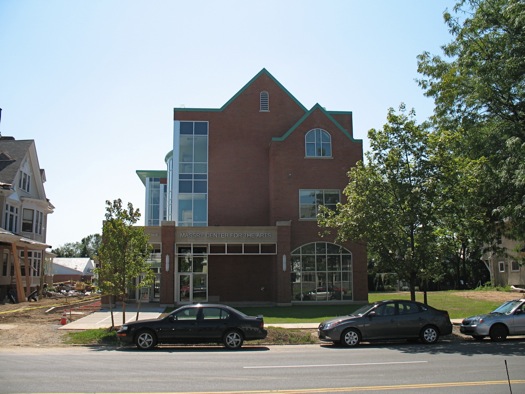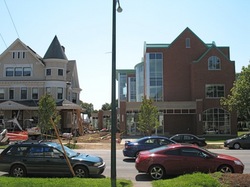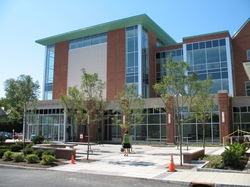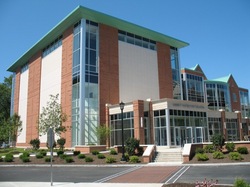A modern building hidden in plain site

Looks can be deceiving... in a good way.
The new Massry Center for the Arts at the College of St. Rose opened this week and it's quite the building. We got a tour yesterday and the place has some really nice spaces.
The thing that really caught our eye even before the place was even finished, though, is the way it fits into the context of the neighborhood surrounding CSR. Massry is a 46,000 square foot building, but it's relatively unassuming in both size and style from Madison Avenue. In fact, the size is almost hidden when you look at it from the street. It's like this modern building has just been discretely tucked into one of Albany's traditional neighborhoods.
Bill Koonz, an architect with Saratoga Associates, designed the Massry Center. We asked him a few questions yesterday about the thinking behind the design.
 What was the starting point for the design?
What was the starting point for the design?
A lot of buildings are really large and stark and really put a flat face up to the street to get as much attention as possible. This one does it a little differently. It really started with how do we create a building that fits into the character of the neighborhood without overpowering it.
The city really needed to keep the character of the neighborhood. The house that was here prior to this had been condemned because of lack of upkeep. So, what we had was really a blank slate. So keeping that character of what you see along Madison Avenue was very important.
Saying that, it was also important we got all the program in here. It's a fairly large building, fairly small footprint. So the height of the building is no higher than the height of the administration building. As we discussed with the city, that was our limit.
So what we have is a building that really steps back, that keeps a smaller face, smaller footprint to the public and enlarges as we go back along the site. Scale was really one of things we tried to bring down as much as possible as we started. As you can see as you walk along the first floor, while we have a 16 foot floor-to-floor height we've done a lot of things through brick detail, through curtain wall use, to help bring that scale down and make it feel more personable. It makes the building feel a lot smaller than it is.
 It would seem like one of the challenges in designing the building would be figuring out how to make a nod toward the style of the neighborhood, but also create something that's modern and forward-looking.
It would seem like one of the challenges in designing the building would be figuring out how to make a nod toward the style of the neighborhood, but also create something that's modern and forward-looking.
Right. You really have two vocabularies here. You've got a collegiate vocabulary that you see across the street which is a lot of brick, a lot of stone on a sort of grandiose scale. And then you have a whole street that's all turn-of-the-century 30s, 40s and 50s homes -- you know, not the grand mansions of Albany, but some of the larger homes in this neighborhood. So, how to address both? That really becomes the problem.
And then not only that, but you have an art building. So how do you blend all three of those issues without really overpowering any of them?
On the plus side, we had a very narrow site. We've all talked about how this site was very difficult to deal with, but on the other side it was real easy to deal with because we had very minimal width to look at from the street.
And then as we came back we could a lot of different things. The building steps back from the first floor to the second -- that's to try to bring some of the scale of the building down from Madison, but also from here to the administration building so that it doesn't fall completely into shadow. And then as we come up to the third floor, the roof is a sloped roof as opposed to being flat to gain sun angles and to help limit the height of the building. Most residences have a sloped roof, this building has a sloped roof a the Madison end for just that reason.
The character of the building changes drastically out here at the main stair [halfway back in the building's middle]. That has to do with the program of the space, but it also has to do with ability to change the character as we're farther away mainly on St. Rose's property.
So what you would expect of a recital hall, that black box mentality, happens back here. We have colored LEDs to light the building on the back that can be changed to any color they want. On the front of the building, it's more traditional -- long wall sconces that accent the wall but don't really pop and make it stand out because it's a more traditional classroom, college building [out front and back there] that's the flash and glitz of a recital hall.
 Why go to the trouble of working within the context of the neighborhood? Why does it matter?
Why go to the trouble of working within the context of the neighborhood? Why does it matter?
A number of reasons. The college lives here. Twenty years ago you would have seen a college or university come through and tear down a section of the neighborhood and put up whatever they wanted. The College of St. Rose has been a great neighbor to this area of Albany. They've tried very hard to work within the context, because they have to live with these people on a daily basis. So that becomes real important, not only to them, but to us as good architecture and good planning and design.
The worst thing you can do in any project is to ignore the context and just bulldoze. Mainly because you're starting to tear apart the fabric.
A great example in Albany is the South Mall. Forty years ago, my parents, my grandparents, lived where the South Mall is. I grew up walking through there. From a
contextual and architectural and planning standpoint, it's a horrible place to put it because it tore down and really ruined the fabric of the City of Albany in a lot of ways. It also did a lot of good things for Albany and kind of insulated it from a lot of the problems that other parts of New York State have. There's that give and take.
This isn't that kind of environment. This had a very distinct footprint and a very distinct function. The city gave us the charge to make sure it fit into the neighborhood. The college gave us the charge to make it sure it was compatible with the neighborhood. They were very clear that their neighbors are important to them. And they wanted to make sure this did the best it could -- it's a university building not a two-family home -- to fit in and not overpower what people are seeing around it.
This interview was edited and condensed.
Hi there. Comments have been closed for this item. Still have something to say? Contact us.
Comments
You know what would have fit “into the context of the neighborhood surrounding CSR†the original building that stood there. A beautiful Queen Anne, similar in height and design to the neighboring Administration building, but extending deeper into the lot. St. Rose purchased this building in in the late 1990's/early 2000's and then sat on it, did nothing to reuse or renovate. And then in 2004/2005 stating that it was a hazard and too expensive to rehab, tore it down. Straight up demolition by neglect.
“A number of reasons. The college lives here. Twenty years ago you would have seen a college or university come through and tear down a section of the neighborhood and put up whatever they wanted. The College of St. Rose has been a great neighbor to this area of Albany. They've tried very hard to work within the context, because they have to live with these people on a daily basis. So that becomes real important, not only to them, but to us as good architecture and good planning and design.â€
As a Pine Hills resident I do not see how any of this statement is true. Little over 5 years ago St. Rose came on through and tore down 5 buildings to construct the Lally Education Building. These buildings razed were occupied buildings; College owned housing, private owned housing and I believe one was a rehab/half way house. While they have to “live with these people†i.e. my neighbors and I, they do not try, they do not work hard to protect and preserve the neighborhood. Which is quite humorous frankly because when you read their publicity information and whatnot, they use this quaint historic neighborhood as a selling point but in actually they are systematically tearing it down.
“What would be good architecture and good planning and design†would be to use the wonderful and quality housing stock that is there. To spend all the money they show upon Saratoga Architects to find an architecture/planning firm to create a cutting edge and sustainable campus using the existing built environment which already defines the character of the campus.
“The worst thing you can do in any project is to ignore the context and just bulldoze. Mainly because you're starting to tear apart the fabric.†Sadly that is exactly what St. Rose has done to the Pine Hills neighborhood.
... said Save Pine Hills! on Aug 22, 2008 at 2:43 PM | link
"The worst thing you can do in any project is to ignore the context and just bulldoze."
Hmm...anyone know what the plans are for the 4 or 5 buildings CSR is bulldozing on Yates St.?
... said jmc on Aug 22, 2008 at 5:05 PM | link
What a wonderful piece of architecture! A job well done. The architect that designed it should be applauded.
... said A. L. Davis on Aug 28, 2008 at 7:54 AM | link